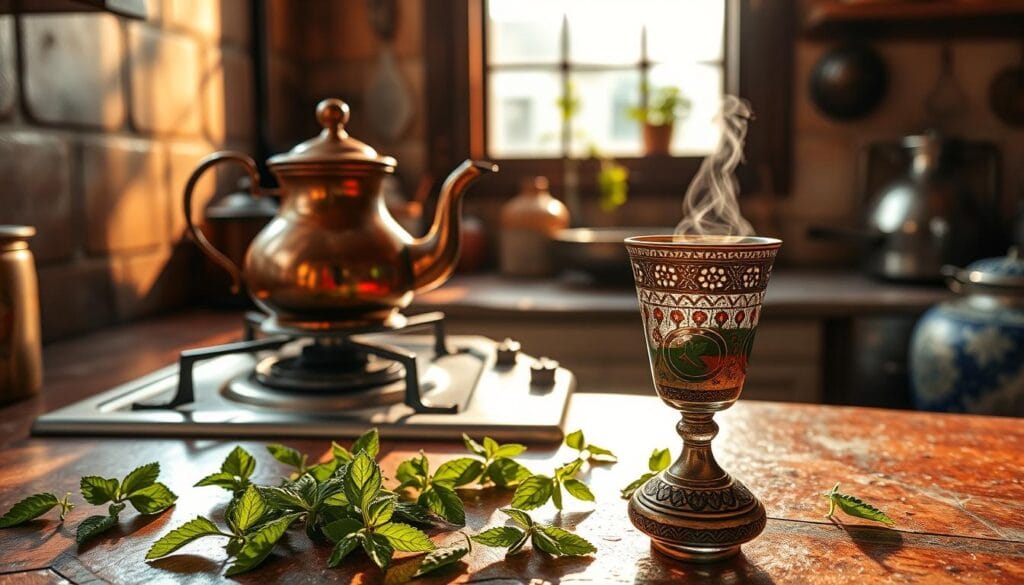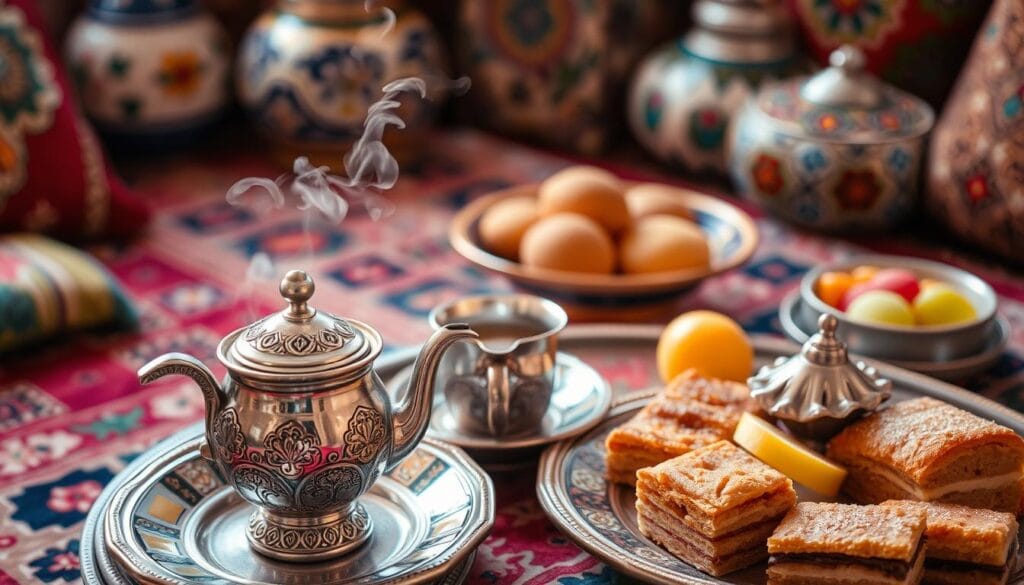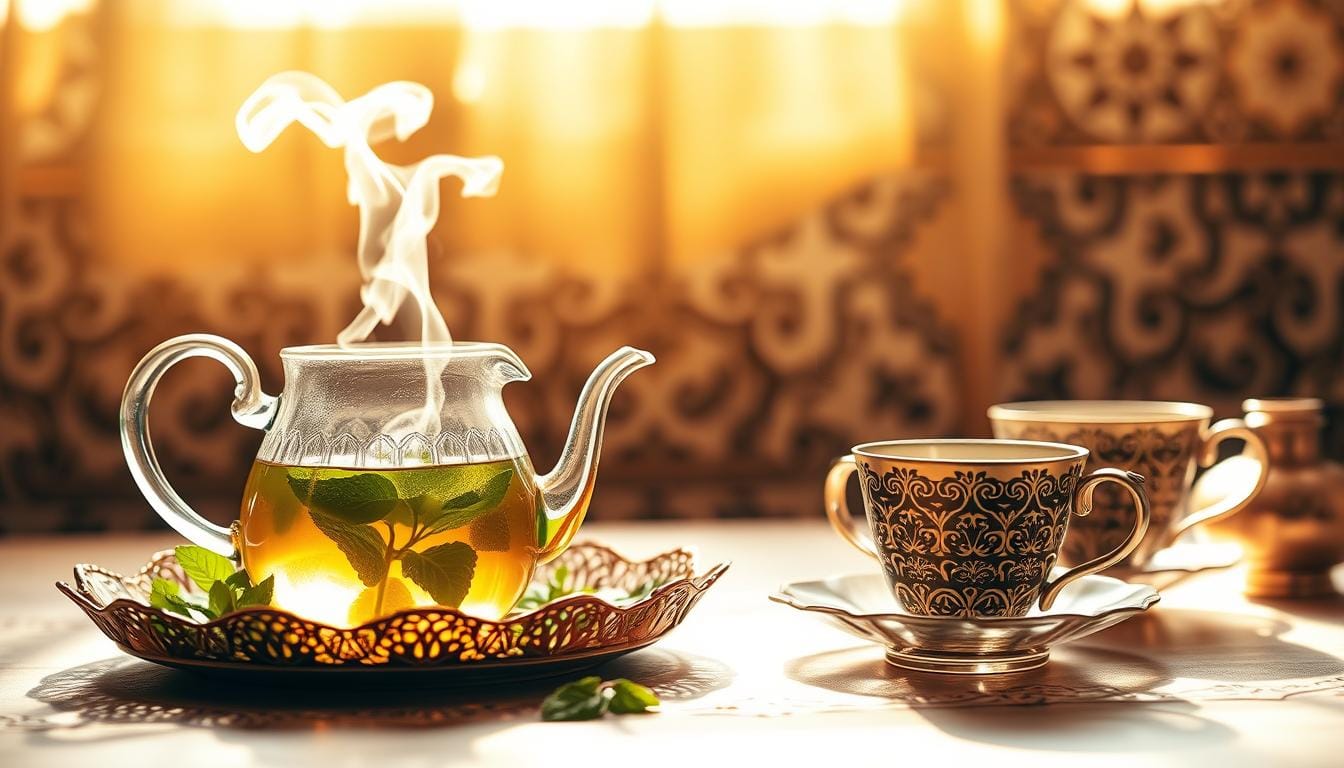Imagine sitting in a Moroccan courtyard, surrounded by sun. The smell of fresh spearmint fills the air as a tea ceremony starts. As you sip warm Mint Tea, also known as Moroccan Atay, the taste of earthy green tea and mint is amazing. It takes you to a place where friendship and community are valued.
This special drink is more than a beverage. It represents the heart of Moroccan culture, creating unforgettable moments. Let’s explore the rich history and importance of this tradition in Moroccan culture.
Key Takeaways
- Mint Tea, or Moroccan Atay, is a key part of Moroccan culture and hospitality.
- This flavorful drink combines Chinese gunpowder green tea with fresh spearmint leaves.
- Moroccan Mint Tea has a rich history dating back to the 18th or 19th century.
- The preparation often includes a sweet component, reflecting its role in gatherings.
- Enjoying Mint Tea is a communal experience, often associated with social bonds.
- It’s celebrated in both homes and public spaces, highlighting its cultural importance.
Understanding Moroccan Mint Tea
Moroccan Mint Tea is a symbol of warmth and welcome in Morocco. The Mint Tea Ritual is key in social events, showing the importance of sharing this drink. It’s made with Chinese green tea and fresh spearmint, creating a sweet and refreshing taste.
The Mint Tea History is filled with tradition that spans many years. Every cup poured is a sign of community, bringing families and friends together. It’s enjoyed at celebrations and casual get-togethers, showing the heart of Moroccan culture and the joy of shared moments.
Ingredients of Authentic Moroccan Atay
The flavors of authentic Moroccan Atay come from three key ingredients. First, we have Chinese Gunpowder Green Tea. It adds depth to the drink.
Chinese Gunpowder Green Tea
This tea has leaves that look like small pellets. When you brew it, it gives a strong, earthy taste. This tea is essential for balancing the flavors of spearmint and sugar.
Fresh Spearmint Leaves
In Moroccan Arabic, they call it “nana”. Fresh spearmint leaves add a refreshing taste. They contrast well with the tea’s strong flavor, making the drink more authentic.
The Role of Sugar in Mint Tea
Sugar is important for adding sweetness and class. In Morocco, they use a lot of sugar. It balances the tea’s earthy taste with the mint’s freshness, creating a perfect drink.
The Cultural Significance of Moroccan Mint Tea
Mint Tea is deeply rooted in Moroccan culture, symbolizing warmth and hospitality. It’s more than just a drink; it carries deep social and cultural values. Enjoying this traditional tea brings people together, fostering a sense of community and friendship.
The Symbol of Hospitality
In Morocco, serving Mint Tea to guests is a key sign of hospitality. It’s a common practice during visits, strengthening bonds between hosts and visitors. Serving tea shows respect, warmth, and a genuine welcome to guests.
Social Gatherings and Mint Tea Rituals
Moroccan Tea Rituals are key in social gatherings. Whether at home or in public, sharing Mint Tea fosters connection. The way tea is served and poured carries deep meaning, showing the host’s dedication and skill.
These gatherings turn simple meetings into special moments of friendship and community. They highlight the importance of Mint Tea in Moroccan culture.
How to Make Moroccan Mint Tea
Making Moroccan mint tea is easy with the right tools and a simple recipe. This drink is not just tasty but also shows Moroccan hospitality. Here’s how to make your own mint tea.
Essential Equipment for Brewing
First, you need some important brewing tools:
- Teapot (commonly known as a “berrad”)
- Fine mesh strainer
- Small tea glasses
Step-by-Step Mint Tea Recipe
- Start by heating water to a boil.
- Rinse the teapot with hot water to warm it up.
- Add a few teaspoons of gunpowder green tea to the pot.
- Rinse the tea briefly with hot water, which enhances flavor.
- Incorporate a generous handful of fresh spearmint leaves.
- Add sugar to taste, balancing sweetness according to preference.
- Pour the hot water over the mixture in the pot.
- Allow it to steep for about 5 minutes.
- Pour the tea from a height into glasses to create a frothy top.
Now you know how to make Moroccan mint tea like a pro. Enjoy this refreshing drink at any time.

Variations and Regional Differences in Mint Tea
Moroccan Mint Tea is known for its unique taste. It has many variations, thanks to local tastes. Each region uses different mints, making each blend special.
Different Types of Mint Used
The most common mint in Moroccan tea is spearmint, or nana. It adds a sweet and cool flavor. Other mints are used too, adding a unique twist. The mint choice shows local tastes and traditions, making the tea even more special.
Sweetness Levels Across Cultures
The sweetness of Moroccan Mint Tea changes with culture. Traditionally, it’s very sweet, almost syrupy. But today, many prefer less sugar. This way, everyone can enjoy the tea, no matter their taste.
| Region | Type of Mint | Typical Sweetness Level |
|---|---|---|
| Morocco (Central) | Spearmint (Nana) | High |
| Western Sahara | Peppermint | Medium |
| Algeria | Spearmint | Lower |
| Tunisia | Fennel Mint | Medium to High |
Health Benefits of Moroccan Mint Tea
Exploring Moroccan Mint Tea’s health benefits shows many advantages. These benefits come mainly from spearmint, a key ingredient. Spearmint is known for aiding digestion, making the tea a great addition to your diet.
Potential Digestive Aids of Spearmint
Spearmint’s benefits go beyond its refreshing taste. It helps ease digestive discomfort by relaxing digestive tract muscles. Drinking Moroccan Mint Tea can help with bloating, gas, and other stomach issues. It’s great after meals, making you feel better and more comfortable.
Overall Health Considerations
While Moroccan Mint Tea is good for your stomach, it’s high in sugar. Too much sugar can cause weight gain and high blood sugar. Enjoying this tea, but watch the sugar. This balance helps you stay healthy.

Mint Tea (Moroccan Atay) Presentation and Serving
The Presentation of Mint Tea is very important in Moroccan culture. It makes the tea-drinking experience special. The traditional elements used create a warm atmosphere, showing Moroccan hospitality.
The Traditional Moroccan Teapot (Berrad)
The Traditional Moroccan Teapot, called a “berrad,” is special. It’s made from metal and has beautiful designs. These designs help brew the tea perfectly, making the mint flavor better.
When you serve Moroccan mint tea, the berrad grabs everyone’s attention. It sets the stage for a wonderful experience.
Importance of the High Pour Technique
The Serving Techniques of Moroccan mint tea include the high pour. This method pours tea from high up into glasses, making it frothy. It also makes the tea taste and smell better.
The high pour adds a showy element to the presentation. It shows the server’s skill and makes the tea ceremony more beautiful. A well-made berrad and the high pour turn simple tea drinking into a grand cultural ritual.
Pairing Food with Moroccan Mint Tea
Pairing food with Moroccan mint tea is a delightful experience. Each sip of this aromatic tea can make different dishes more enjoyable. In Moroccan culture, food and tea together are more than just flavors. They celebrate rich culinary traditions.
Sweet Treats and Pastries
Moroccan pastries like baklava and almond briouates go well with mint tea’s sweet notes. The honey in baklava and the nuttiness in briouates add to the tea’s sweetness. Other great choices include:
- Maamoul (stuffed cookies)
- Kahk (powdered cookies)
- Chbakia (fried sesame pastries)
Savory Dishes that Complement Mint Tea
Savory dishes also pair well with Moroccan mint tea. Meals like tagines and couscous bring out the tea’s refreshing qualities. Try these options:
- Lamb tagine with apricots
- Vegetable couscous
- Chicken tagine with olives

The mix of sweet and savory shows Moroccan mint tea’s versatility. Whether you pick rich pastries or hearty dishes, it’s a memorable experience. You’ll enjoy every bite and sip.
Modern Takes on Moroccan Mint Tea
Lifestyles change, and so do our foods. Modern Mint Tea shows new ways to enjoy it, keeping its special charm. People now look for healthier options, leading to new recipes.
Less Sugar, Alternative Sweeteners
Many want to eat less sugar. Less sugar options in Mint Tea are becoming popular. You can use honey or agave syrup instead of sugar. This change is part of a bigger move towards healthier drinks.
Iced Versions for Warm Climates
In hot places, Iced Moroccan Mint Tea is a cool twist. It’s made like usual tea, then chilled or served over ice. This version is perfect for summer, blending new tastes with tradition.
Concluding Thoughts on Moroccan Mint Tea
Moroccan Mint Tea is more than just a drink; it’s a key part of Moroccan culture. It brings people together, whether it’s a small family gathering or a big celebration. When you drink it, you join in a tradition loved for many years.
The way Moroccan Mint Tea is made shows great respect for the tradition. Every step, from the pouring to the choice of ingredients, makes it special. It’s a taste of the harmony found in Moroccan culture.
Think about the lasting effect of Moroccan Mint Tea. It’s loved around the world, bringing warmth and hospitality into homes. Sharing it with loved ones keeps its tradition alive. It’s not just a drink; it’s a celebration of life itself.

